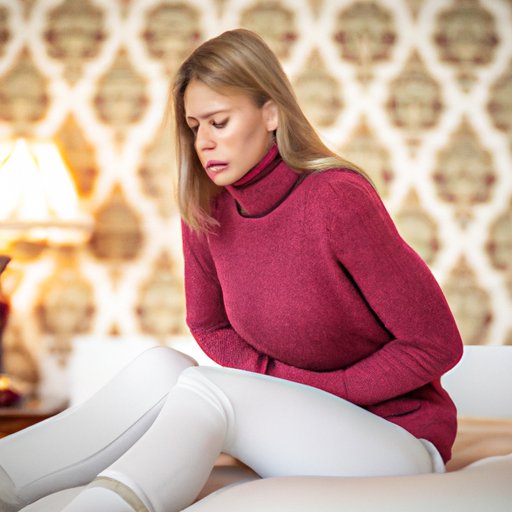
Introduction: Understanding Endometriosis Symptoms
Endometriosis is a female reproductive disorder that affects millions of women worldwide. It occurs when tissue similar to the lining of the uterus grows outside of the uterus, causing inflammation, irritation, and scarring. One of the most challenging aspects of endometriosis is recognizing its symptoms, which can be misattributed to other medical conditions or dismissed as “normal” menstrual pain. In this article, we will explore the most common and lesser-known symptoms of endometriosis, how to identify them, and strategies for managing them.
Recognizing the Signs and Symptoms of Endometriosis
Endometriosis can cause a range of symptoms and can vary in severity and frequency between individuals. However, the most common symptoms of endometriosis may include:
Painful periods
Painful periods, or dysmenorrhea, is a hallmark symptom of endometriosis. Women may experience cramping, lower back pain, heaviness and pressure in the pelvic region, and pain during bowel movements or urination. Unlike typical menstrual cramps, which tend to subside as the period progresses, endometriosis-related pain may worsen over time.
Pain during sex
Endometriosis can also cause pain or discomfort during sex, which can impact sexual pleasure and intimacy. The pain may be sharp or cramp-like, and may be felt during or after intercourse.
Chronic pelvic pain
Many women with endometriosis experience chronic pelvic pain that does not go away after the period ends. This pain can range from moderate to severe and may interfere with daily life and activities.
Fatigue
Fatigue is a common symptom of endometriosis, and women may experience tiredness, weakness, and low energy levels throughout their menstrual cycle.
Infertility
Endometriosis can also impact fertility by causing scarring, inflammation, and the formation of ovarian cysts. According to the Endometriosis Foundation of America, up to 50% of infertile women have endometriosis.
The Silent Pain: Understanding Endometriosis Symptoms
Unfortunately, endometriosis symptoms can often go unrecognized or misdiagnosed. Many women may experience what is commonly referred to as “silent” pain, or symptoms that are present but not immediately noticeable. Some of the lesser-known symptoms of endometriosis may include:
Painful bowel movements
Endometriosis can cause significant pain during bowel movements, which may be mistaken for gastrointestinal issues like irritable bowel syndrome (IBS).
Painful urination
Similarly, endometriosis-related pain during urination can be misattributed to urinary tract infections (UTIs) or other bladder issues.
Lower back pain
Back pain is a common symptom of endometriosis, as the condition can cause inflammation and nerve compression in the lower back. This pain may be present during the menstrual cycle or continuously.
Digestive issues
Endometriosis can cause a range of digestive issues like bloating, constipation, diarrhea, and nausea, which can be mistaken for other gastrointestinal issues.
It is essential to recognize these lesser-known symptoms and bring them to the attention of a healthcare provider, especially if they persist or worsen over time. Let’s look at some practical tips for identifying endometriosis symptoms.
Living with Endometriosis: Identifying the Tell-Tale Symptoms
If you suspect you may have endometriosis, it’s important to keep track of your symptoms using a symptom diary. This diary should include details like the date, time, and severity of your symptoms, as well as any factors that may have triggered them (such as stress, food, or exercise).
Other tips for identifying endometriosis symptoms may include:
– Pay attention to menstrual cycle changes, including the duration and intensity of your periods, and any spotting or bleeding between periods.
– Notice any abdominal swelling, tenderness, or bloating.
– Ask yourself whether you experience pain or discomfort during sex, bowel movements or urination.
– Reflect on whether you have experienced a significant reduction in your quality of life or daily functioning due to symptoms.
If your symptoms persist or worsen, it may be time to see a healthcare provider for further evaluation and diagnosis.
Painful Periods? It Could Be Endometriosis – Learn the Symptoms
One of the most common symptoms of endometriosis is painful periods, which can range from mild discomfort to severe pain. For women with endometriosis, periods may be longer, heavier, and accompanied by clots or tissue.
To manage period pain caused by endometriosis, some practical tips may include:
– Using over-the-counter pain relievers like ibuprofen or acetaminophen to manage pain and inflammation.
– Using heating pads or warm baths to alleviate cramping and soreness.
– Drinking plenty of water and staying hydrated.
– Resting when necessary and avoiding strenuous exercise during periods.
– Talking to your healthcare provider about prescription medication options for managing period pain.
When Pain Becomes More Than a Monthly Occurrence: Symptoms of Endometriosis
Chronic pain is a key symptom of endometriosis, and it can significantly impact quality of life and daily functioning. Endometriosis pain can differ from other types of pelvic pain in several ways. For example:
– Endometriosis pain may be sharper, more stabbing, or cramp-like.
– Endometriosis pain may be more concentrated in specific areas of the pelvic region.
– Endometriosis pain may be more consistent and may not correlate with menstrual periods.
In addition to physical symptoms, endometriosis can also cause psychological distress and emotional health issues, such as depression, anxiety, and mood swings.
The Importance of Recognizing Endometriosis Symptoms and Seeking Treatment
Early diagnosis and treatment are crucial for managing endometriosis and preventing complications like infertility and chronic pain. Treatment options for endometriosis can vary depending on the severity of symptoms and may include medication, surgery, or lifestyle changes like diet and exercise.
It’s essential to seek help from a healthcare provider if you suspect you may have endometriosis, and to advocate for your health and well-being. You can also seek support from organizations like the Endometriosis Association and the National Association for Premenstrual Syndrome.
Conclusion
Endometriosis is a challenging condition to manage, but recognizing its symptoms early on is the first step in preventing complications and improving quality of life. Remember to keep track of your symptoms and to seek help if they persist or worsen. Living with endometriosis is possible with the right diagnosis, treatment, and support.




